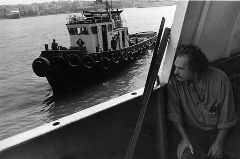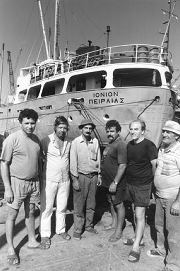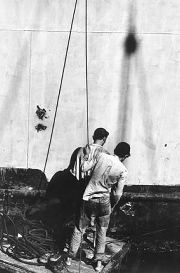

|
| Untitled, 1963 |
In the early Sixties, Jannis Kounellis made his appearance in the world of art with a highly individual plastic vocabulary which initially resembled a codified script in the form of letters and equations and later led to the formation of images - images consisting of heterogeneous objects (industrial or natural products) and beings which functioned as images and references to the mythical, cultural or more recent industrial and urban past and which are converted into silent or strident, static or mobile events of great significance.

|
| Untitled, 1967 |
Consciously inheriting and expressing a particularly rich culture, Kounellis has succeeded, in the course of a difficult struggle and a constant onward journey, in providing his own definition of the artist as a tragic and contemporary hero. The whole of his work is marked by continuous to-ing and fro-ing between memory, history and realistic actuality, with prolonged silences and moments of tortured poetic exaltation, in which are to be encountered carefully selected elements capable of stirring up the memory, of extolling the measure of man, of revitalising the myth and of employing archetypes and moments from the European culture of the distant and recent past.

|
| Untitled, 1969 |
Thus, while his style is made up of a personal experiential code, it is transformed into a visual art vocabulary of a widely legible symbolist character which occupies a position of importance in the history of contemporary European art. The work of Kounellis with that of Joseph Beuys is a moment of the greatest importance in the interpetation of the post-war world- Although, as is often maintained, art is a personal affair, it nevertheless does not cease to have a social character. The personal peregrinations of the artist are reflected in his work and inevitably become part of the itinerary of art.

|
| Untitled, 1969 |
Jannis Kounellis is a great traveller, one who through his wanderings incarnates ideas in works. In the case of Kounellis, however, there are many reasons for speaking of a 'voyage' rather than a peregrination - or even better, of an 'Odyssey across the Lake', as he himself has called it, in a reference not only to the finite nature of the Mediterranean basin but also to the beginnings of a cultural locus which he expresses as few others do. Kounellis' relationship with the sea is as old as it is natural. It was only to be expected that his birthplace of Piraeus, his family background and the historical past of the country from which he comes should create an indissoluble bond between him and the sea.

|
| Untitled, Venice 1974 |
His identification with the wandering hero of Homer - and still more with Joyce's character - led him to stages in his work which refer closely to the sea itself, as a channel of communication, and to the idea of the voyage. He has travelled constantly, in both the practical and metaphorical senses. Departure, the way-station, and return - a return which is of necessity temporary on this voyage without end, this cyclical journey - all these events have left their mark on his itinerary and on his iconography. Between exhibitions in museums and galleries, between happenings and stage designs, Kounellis has 'put in' from time to time at real ports, impelled by the persistence of an inexhaustible idea.
The main way-stations, directly associated with the idea of sea voyages and ships, have been Naples in 1969, Venice in 1974 and Berlin in 1991, when he achieved a harmonious symbiosis of two versions of reality which though theoretically incompatible are both essential to him: the classic exhibition venue, and the sea as natural space. The Albatross of the Metropolis, an old and broken hulk, is not, as was the case in the past, a metaphorical and symbolic image of the sea and ships in a single enclosed exhibition space (e.g. Untitled, Bologna 1978, Untitled, Milan 1979); it is the truth of the sea itself in a single museum space. It is the transfusion of one space into another, the simultaneous presentation of one version of reality within another. This idea, which has clearly preoccupied Kounellis in the whole of his work, enabling him to make compositions 'from the life' out of the impoverished by tangible reality of a jacket, a lump of charcoal, an old piece of wood, a stone, a plaster copy of an ancient head, and so on, leads him to create real pictures - as if he had abandoned easel painting only to return to it by putting a frame around reality itself in order to create his 'painting'.

|
The same painterly quest, in dramatic dialogues and questions, in poetic and subversive acts, in enforced strategies of defence and attack, led him to his last and most important maritime way-station: the Piraeus exhibition of 1994. This exhibition, organised by the J.F. Costopoulos Foundation and held in the hold of the Ionion, a working cargo vessel, was at the same time the artist's first retrospective exhibition in Greece. The idea of holding the exhibition on board ship belonged to Kounellis himself.
As he has frequently done throughout his career, here, too, he was looking for a space which was suitable for his work and not for a space to which the work could be adapted. For Kounellis, space is above all ideology, and he has never ceased to demonstrate this in practice and to repeat it. The ship's hold was thus subjected to a poetic subversion of its previous function. Its usual cargoes - maize, wheat, fertilisers - were replaced by a series of works covering the period from 1967 to the present day, in which the artist's Odyssey is recorded in more or less overt personal and cultural references and memories.

|
In spite of this, the cargo vessel continued to operate normally. With great respect for the space as an integral part of the work and as its main body, Kounellis managed to achieve not only osmosis between the exhibition space and real space but also the incorporation into his work of all the physical and human resources of the ship. The crew, under the provisional command of a rather unusual captain, were ever-present and agreed to take an active part in the undertaking, keeping the cargo vessel operative throughout the exhibition and being photographed for the poster and the book. In this way, the crew became an organic part of the exhibition. This visual arts event, described by many as Jannis Kounellis' return home, was no more - in my opinion - than another way-station on his everlasting journey, one which has the value of a return not as an event but as a concept. It was the creation of another reality, but one in which many other realities were inherent both formally and conceptually.
It was also a blend of works from the distant and recent past, of fragments which, in a manner similar to that of C.P. Cavafy, were magically blended into a single work, a unique entity marked both by the artist's journey and by the drama of fragmentation. From this process resulted a work which corresponded, despite its apparent contrasts, to Kounellis' Apollo, of 1973. The hull of the Ionion was not only a womb protecting the works, the hollow space in which a metaphorical genesis could take place; it was also the location of a real genesis, the genesis of the new single work of which, simultaneously, it was part, standing as one of the decisive components of the exhibition.

|
Both bearing and borne, it gave up the sides of its interior for Jannis Kounellis to paint a mural on, for him to 'moor' other works against, and for him to construct a new space within a fully-operating living organism. Using the historical synthetic approach which Italy taught him and combining it with his own profound analytical thought, Kounellis occupied the space absolutely, endowing it with a unique atmosphere. He composed a huge mosaic, a jigsaw puzzle in which the most prominent parts were some of the most important works of previous years. The cargo vessel was berthed at the very heart of a harbour which, as is natural, had a life of its own in light and dark shades; with the crew always on duty and the engines running, ready at any moment to sail, it seemed to breathe rhythmically with the movement of the sea - which the artist was able to record, whose pulse he took in a work made specially for the exhibition.
The sound of the water and the creaking of the ship helped to create an incomparable atmosphere and provided unique background music for the exhibition. The enclosed, forbidden interior of the ship opened outwards. Although there was nothing nostalgic about the weak ship's light shining from the gaping cargo port, it made the interior of the vessel a place of initiation and communication. The Ionion, an unusual venue for an exhibition and one which was ever-present as the exhibition was recorded in history, became a short-lived ghost museum - temporary because the 'captain' wished to return only for a little while to the old meeting-place: the Town Clock, once the symbol of Piraeus and now gone for ever along with so much else.
From that meeting, however, the reality of the exhibition remains, along with the truth of creation and the dynamics of the work, simultaneously with the symbolic gesture of an artist who continues to wish for "the return of poetry by every means, by spiritual exercise, observation, solitariness, discourse, image, revolt".
This text by Katerina Koskina is based on an essay published in Kounellis - Mistral, Edizione Bolis, Bergamo 1996 (Greek text published in the same year by Alfa Credit Bank and Edizione Bolis).
The photos in this text are from Yannis Kounellis' book "Odyssey across the Lake", AGRA Publishing Co - Bernier Gallery, Athens, 1990, and from the photographic material provided by Manolis Babousis